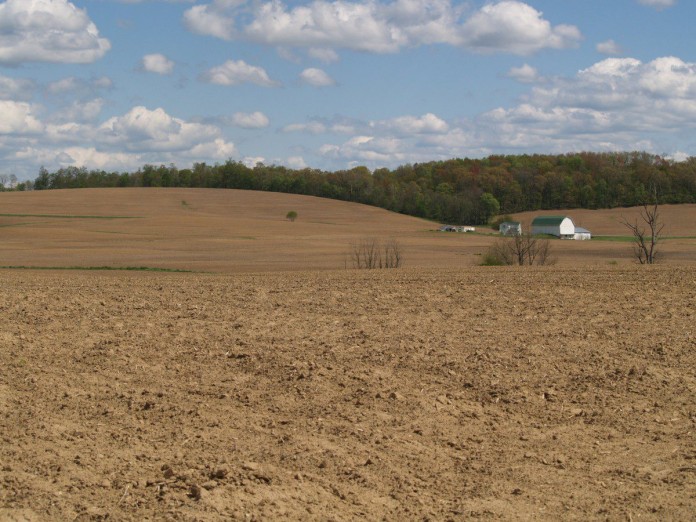COLUMBUS — While cropland values in Ohio increased in 2012 and 2013, they are expected to remain flat or even decline in 2014, an economist from Ohio State University’s College of Food, Agricultural, and Environmental Sciences said.
Ohio cropland value rose 12 percent this year, with bare cropland averaging $5,600 an acre, said Barry Ward, production business management leader for OSU Extension.
Ward, citing statistics from the Ohio Field Office of the National Agricultural Statistics Service, said he expects the trend to remain flat or even reverse next year, with the key factors — crop profitability and interest rates — both showing indications of “unfriendly” moves in 2014.
Lower profits
This, as crop profits are projected to be lower or possibly negative while interest rates have moved higher since last year, he said.
“Projected budgets for Ohio’s primary crops for 2014 show the potential for little to no profits,” Ward said. “Cash rental rates will move based on where they are in relation to the current market.
“Rents at the low end of the market may have some upside potential yet as they catch up. Rents at the high end of the market will be sticky as operators may be reluctant to ask for relief after one year of low prices for fear of losing part of their land base.”
Ward spoke Nov. 25 during the college’s kickoff of its 2013-2014 Agricultural Policy and Outlook series. The event initiates a series of local meetings to be held statewide through the end of the year.
Dates and times for the meetings can be found at http://go.osu.edu/2014outlook. The event featured presentations from experts from the college’s Department of Agricultural, Environmental and Development Economics, who discussed issues the food and agricultural community should expect in 2014, including policy changes and market behavior with respect to farm, food and energy resources, and the environment.
Producers and landowners may want to consider flexible cash leases as a way to manage risk of volatile crop and input markets, said Ward, who is also an AEDE assistant extension professor.
Input costs
Fertilizer will continue to be the most volatile crop input cost, Ward said, noting that “cost management of this important input may be the difference in being a low cost or high cost producer.”
“Fertilizer prices are lower compared to last year at this same time and many producers are asking themselves if this is the right time to buy,” he said. “While it is hard to know exactly what direction and when prices will move, it is smart to keep up to date on important fertilizer products fundamentals.”
Depending on land production capabilities, returns to land are projected to be $17 to $213 per acre for Ohio corn next year, Ward said.
Returns to land for soybeans are projected to be $62 to $248, with returns to land for wheat projected at $25 to $159.
The projections are based on OSU Extension Ohio Enterprise Budgets, and assume current prices of inputs and current December, November and September 2014 futures prices, respectively.
Starting point
OSU Extension has a long history of developing enterprise budgets that can be used as a starting point for producers in their budgeting process. Farmers can find enterprise budgets for 2014 at http://aede.osu.edu/research/osu-farm-management/enterprise-budgets. The website is offered by AEDE.
The budgets are downloadable Excel spreadsheets. Users can input their production and price levels to calculate their numbers. The budgets feature color-coded cells that allow users to plug in numbers to easily calculate bottom lines for different scenarios. Detailed footnotes are included to help explain methodologies used to obtain the budget numbers.
The budgets also include a date in the upper right-hand corner of the front page indicating when the last update occurred.











I feel, this is justice after the CAFO industry has created such losses for the neighbors. I walked away from my home since 1976, when after 26 years it could not sell due to the ten poultry buildings 500 feet directly west of it. Farmers did not think this was wrong so I feel what is happening to the land prices is not wrong also. Land prices swing like a pendulum and they are on the down ward trend.